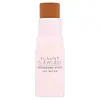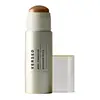What's inside
What's inside
 Key Ingredients
Key Ingredients

 Benefits
Benefits

 Concerns
Concerns

 Ingredients Side-by-side
Ingredients Side-by-side

Octyldodecanol
EmollientC12-15 Alkyl Benzoate
AntimicrobialSilica
AbrasiveSynthetic Wax
AbrasiveDimethicone
EmollientCetearyl Ethylhexanoate
EmollientMica
Cosmetic ColorantPolyglyceryl-2 Triisostearate
EmulsifyingEuphorbia Cerifera Wax
Caprylic/Capric Triglyceride
MaskingSilica Silylate
EmollientMethicone
EmollientPhenoxyethanol
PreservativeStearalkonium Hectorite
Gel FormingTocopheryl Acetate
AntioxidantMangifera Indica Seed Butter
Skin ConditioningLimnanthes Alba Seed Oil
Skin ConditioningSimmondsia Chinensis Seed Oil
EmollientPropylene Carbonate
SolventAluminum Hydroxide
EmollientCI 77891
Cosmetic ColorantCI 77491
Cosmetic ColorantCI 77492
Cosmetic ColorantCI 77499
Cosmetic ColorantOctyldodecanol, C12-15 Alkyl Benzoate, Silica, Synthetic Wax, Dimethicone, Cetearyl Ethylhexanoate, Mica, Polyglyceryl-2 Triisostearate, Euphorbia Cerifera Wax, Caprylic/Capric Triglyceride, Silica Silylate, Methicone, Phenoxyethanol, Stearalkonium Hectorite, Tocopheryl Acetate, Mangifera Indica Seed Butter, Limnanthes Alba Seed Oil, Simmondsia Chinensis Seed Oil, Propylene Carbonate, Aluminum Hydroxide, CI 77891, CI 77491, CI 77492, CI 77499
Coco-Caprylate/Caprate
EmollientOctyldodecanol
EmollientCaprylic/Capric Triglyceride
MaskingSilica
AbrasiveDiisostearyl Malate
EmollientHelianthus Annuus Seed Wax
Skin ConditioningC10-18 Triglycerides
EmollientPolyhydroxystearic Acid
EmulsifyingCaprylic/Capric/Myristic/Stearic Triglyceride
EmollientStearyl Behenate
EmollientDicalcium Phosphate
AbrasiveSimmondsia Chinensis Seed Oil
EmollientStearalkonium Hectorite
Gel FormingSorbitan Isostearate
EmulsifyingPolyglyceryl-2 Triisostearate
EmulsifyingIsostearic Acid
CleansingLecithin
EmollientPolyglyceryl-3 Polyricinoleate
EmulsifyingBlakeslea Trispora Mycelium Extract
Propylene Carbonate
SolventSilica Silylate
EmollientTitanium Dioxide
Cosmetic ColorantBlue 1 Lake
Cosmetic ColorantCI 77491
Cosmetic ColorantCI 77492
Cosmetic ColorantCI 77499
Cosmetic ColorantCoco-Caprylate/Caprate, Octyldodecanol, Caprylic/Capric Triglyceride, Silica, Diisostearyl Malate, Helianthus Annuus Seed Wax, C10-18 Triglycerides, Polyhydroxystearic Acid, Caprylic/Capric/Myristic/Stearic Triglyceride, Stearyl Behenate, Dicalcium Phosphate, Simmondsia Chinensis Seed Oil, Stearalkonium Hectorite, Sorbitan Isostearate, Polyglyceryl-2 Triisostearate, Isostearic Acid, Lecithin, Polyglyceryl-3 Polyricinoleate, Blakeslea Trispora Mycelium Extract, Propylene Carbonate, Silica Silylate, Titanium Dioxide, Blue 1 Lake, CI 77491, CI 77492, CI 77499
Ingredients Explained
These ingredients are found in both products.
Ingredients higher up in an ingredient list are typically present in a larger amount.
This ingredient is an emollient, solvent, and texture enhancer. It is considered a skin-softener by helping the skin prevent moisture loss.
It helps thicken a product's formula and makes it easier to spread by dissolving clumping compounds.
Caprylic Triglyceride is made by combining glycerin with coconut oil, forming a clear liquid.
While there is an assumption Caprylic Triglyceride can clog pores due to it being derived from coconut oil, there is no research supporting this.
Learn more about Caprylic/Capric TriglycerideCi 77491 is also hydrated iron III oxide. It's sole purpose is to give a red/pink hue to products.
Iron III oxides are classified as inorganic chemicals for coloring.
Synthetically created Ci 77491 is considered safer than those naturally found. This is because the synthetically created version may contain less impurities. Iron oxides are generally non-toxic and non-allergenic.
Learn more about CI 77491Ci 77492 is also hydrated iron III oxide. It's sole purpose is to give a yellow hue to products.
Iron III oxides are classified as inorganic chemicals for coloring.
Synthetically created Ci 77492 is considered safer than those naturally found. This is because the synthetically created version may contain less impurities. Iron oxides are generally non-toxic and non-allergenic.
Learn more about CI 77492Ci 77499 is also hydrated iron III oxide. It is created from mixing red and black iron oxides. This helps give shades of darkness to a product.
Iron III oxides are classified as inorganic chemicals for coloring.
Octyldodecanol is a fatty alcohol. It is primarily used to enhance the texture of products.
As an emulsifier, Octyldodecanol helps prevent the oils and waters from separating. It also prevents ingredients from creating foam when shaken.
Octyldodecanol is created by reducing fatty acid to an alcohol.
Due to its high molecular weight, it does not get absorbed into the skin.
Learn more about OctyldodecanolThis ingredient is a form of glycerin with emulsifying and emollient properties.
As an emulsifier, this ingredient helps keep products together while adding a thick texture. The manufacturer states this ingredient has emollient properties. Emollients help keep the skin hydrated by trapping moisture in.
Polyglyceryl-2 Triisostearate is created by reacting diglycerin and isostearic acid. Due to the isostearic acid base, it may not be safe for Malassezia or fungal acne.
Learn more about Polyglyceryl-2 TriisostearateThis ingredient is a solvent. It helps dissolve active ingredients and alter the texture of products.
Propylene Carbonate is commonly used in makeup and with clay, such as montmorillonite or bentonite.
Studies show this ingredient to be safe for cosmetics. When it is undiluted, it can cause skin irritation. (It is always diluted in skincare and makeup). This ingredient is water-soluble.
Propylene Carbonate is created from propylene glycol and carbonic acid.
Learn more about Propylene CarbonateSilica, also known as silicon dioxide, is a naturally occurring mineral. It is used as a fine, spherical, and porous powder in cosmetics.
Though it has exfoliant properties, the function of silica varies depending on the product.
The unique structure of silica enhances the spreadability and adds smoothness, making it a great texture enhancer.
It is also used as an active carrier, emulsifier, and mattifier due to its ability to absorb excess oil.
In some products, tiny microneedles called spicules are made from silica or hydrolyzed sponge. When you rub them in, they lightly polish away dead skin layers and enhance the penetration of active ingredients.
Learn more about SilicaSilica Silylate is a siloxane polymer, meaning it is made up of silicon and oxygen atoms. It is not soluble in water.
This ingredient is a white powder with oil-absorbing, emollient, and anticaking properties.
This oil comes from the seeds of the desert shrub called Jojoba. It is more commonly known as jojoba oil, a non-comedogenic oil.
Jojoba oil does not contain fragrance and has many fatty-acids, making it a great soothing ingredient.
It also contains Vitamin E, a great moisturizing ingredient. Vitamin E is also an antioxidant and protects your skin against oxidative damage.
This ingredient humectant properties, meaning it helps draw moisture from the air. This helps keep your skin hydrated.
While jojoba has antibacterial properties, it is only able to kill some strains of bacteria.
Studies also show it helps in wound healing. In fact, Indigenous cultures have used jojoba as a moisturizer and to help treat burns for centuries.
Fun fact: Jojoba oil similar to natural human skin sebum, so it has a great effect on dry skin. It is also promising with helping to regulate sebum production.
Due to its fatty acid content, Jojoba oil may not be fungal acne safe. We recommend speaking with a professional if you have any concerns.
Learn more about Simmondsia Chinensis Seed OilStearalkonium Hectorite is a clay-derived ingredient used to thicken a product and help create a gel-like texture.